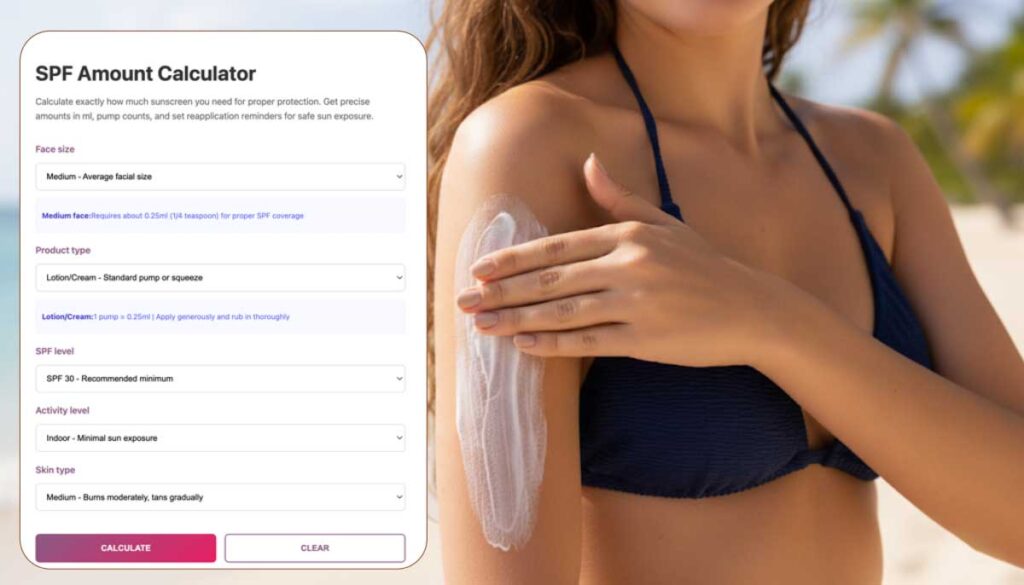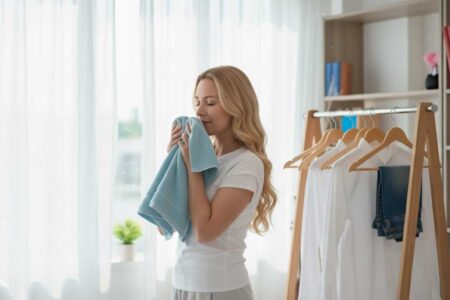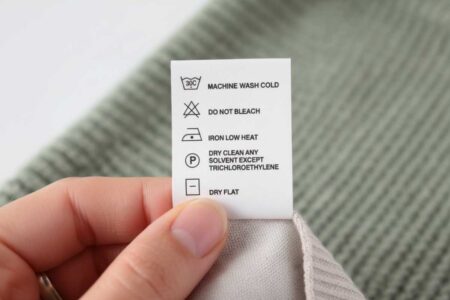SPF Amount Calculator
Calculate exactly how much sunscreen you need for proper protection. Get precise amounts in ml, pump counts, and set reapplication reminders for safe sun exposure.
SPF Application Guidelines
- Apply generously: Most people use only 25-50% of the recommended amount
- Apply 15-30 minutes before sun exposure to allow proper absorption
- Reapply every 2 hours or immediately after swimming, sweating, or toweling
- Don't forget often-missed spots: ears, neck, feet, lips, and around eyes
- Use water-resistant SPF for swimming or sweating activities
- Check expiration dates - expired sunscreen loses effectiveness
- Combine with other protection: hats, sunglasses, and protective clothing
SPF Amount Calculator is here to end the guessing. You already know sunscreen matters, the hard part is how much to use and when to reapply. Pick your face size and product, the calculator returns ml, pumps or spray seconds, plus a timer.
Quick answer
- Pick your face size, small, medium, or large.
- Choose lotion, stick, or spray, then hit calculate.
- You will see ml for face, pumps or spray seconds, and a reapply timer.
- I use the same lab rate they test SPF with, 2 mg per cm², then convert it to pumps and teaspoons so it is easy to follow.
How the calculator works
Do this
- Choose face size.
- Select product type.
- Tell me if you will be indoors, outdoors, or in water.
- Tap calculate.
You get
- Ml per application tuned to your face size.
- Pumps or spray seconds based on your dispenser.
- A reapply timer set for outdoor use, with an option to shorten it during swimming or heavy sweat if your label is water resistant.
The math, human style
- Labs test SPF at 2 mg per cm².
- For a medium face, that works out to about 0.9 ml, which is near two pumps if your pump is 0.5 ml.
- For sprays, I start you at about 1 ml per second as a safe default. You can enter your can’s actual flow after a quick test.
Quick face size guide
These are ballpark face areas so you have a starting point. I pair each with a simple object and a teaspoon range.
- Small, about 350 cm², think poker card, 0.7 to 0.9 ml, close to ⅛ tsp.
- Medium, about 450 cm², think passport, 0.9 to 1.1 ml, around 0.18 tsp.
- Large, about 600 cm², think small paperback, 1.2 ml or more, near ¼ tsp.
Most of us apply less than we think. Matching the lab amount is what keeps the label honest.
What I tried and what actually worked

I used to do one pump and go. Then I measured my airless pump into a spoon and found it only delivered 0.3 ml. No wonder my nose burned on lunchtime walks. I moved to two pumps and set a two hour reminder on park days. Burns stopped, my T-zone did not turn greasy, and I stopped wasting product.
Two tiny wins that stick:
- Keep a stick for ears, hairline, and around the eyes. It is quick and neat.
- Save a preset once you know your pump or spray rate, so tomorrow is tap and done.
If texture is your struggle, these non greasy face sunscreens are a good place to start.
How to calculate SPF 50 and “SPF time,” reality check

SPF is a lab ratio, not a clock. SPF 30 and SPF 50 both need the same amount of product. Real burn time changes with UV index, time of day, and how the product wears. The safe habit is reapply every two hours outdoors, and right after swimming or heavy sweating. The “water resistant 40 or 80 minutes” text on a label is about how long it held up during swim or sweat tests. It is not a full day promise.
Lotion pumps, sticks, and sprays, how to count
Lotion or gel: Many face pumps push 0.5 to 1.0 ml per press. Measure yours once. Pump into a 1 ml syringe or a measuring spoon, divide total ml by number of pumps, enter that number, and you are set.
Stick: Use back and forth passes, then rub in. The calculator maps passes to the same ml target so you do not shortchange ears, hairline, and around the eyes. If you want a quick primer on formats, here is sunscreen vs stick with pros and cons.
Spray: Spray into hands for face, then rub in. Avoid wind, keep the nozzle close, and look for an even sheen.
Calibrate once: spray into a paper cup on a kitchen scale for 5 seconds. Note grams, divide by seconds. That is your ml per second. Enter it and save.
Crosslink inside this guide: if you plan to use spray for larger areas, jump down to Spray sunscreens that actually work, then come back here to set your amount.
Common mistakes and easy fixes
- Relying on SPF in makeup: Makeup with SPF rarely reaches the tested amount. Smooth on a real sunscreen first, then reapply with a stick or cushion later so makeup stays put. If cloudy weather tempts you to skip, here is when sunscreen on cloudy days still matters.
- Skipping ears, hairline, eyelids, and lips: These are the classic hot spots. Use a stick for precision and add SPF lip balm. For the hair part and scalp, here is how to protect hair and scalp without grease.
- Thinking SPF 100 means all day: High numbers do not change the two hour rhythm outdoors. Amount and reapply still rule.
- Spraying in wind: Half your mist blows away. Choose lotion on windy days, or spray in still air and rub in.
Step by step, your first run
- Pick small, medium, or large face size.
- Choose lotion, stick, or spray.
- Enter pump size if you know it, or leave the default and test later.
- Select water resistance if the label says 40 or 80 minutes.
- Tap calculate. Save the preset so next time is instant.
Spray sunscreens that actually work
Sprays are convenient, but it is easy to underuse them. Hold the nozzle close, spray until the skin glistens, then rub in for even coverage. For body, a simple habit is about ten seconds per limb in still air. For face, spray into hands first, then apply. If wind picks up, switch to lotion.
Return to Lotion pumps, sticks, and sprays above to confirm your numbers.
Source insights
Dermatologists at the American Academy of Dermatology advise reapplying every two hours outdoors, and right after swimming or sweating. The Skin Cancer Foundation echoes that daily broad spectrum SPF 30 or higher is a solid baseline for most people. The U.S. FDA explains why labels say “water resistant 40 or 80 minutes,” and reminds us that no sunscreen is waterproof. I follow these groups because they set the consumer guidance and labeling rules most of us rely on.
FAQs
How much is 2 mg per cm² for face?
For most faces, about 0.8 to 1.2 ml. On many pumps, that is 2 to 3 presses.
Is a quarter teaspoon enough for face?
Sometimes. Faces differ in size, so the calculator is more precise than a blanket teaspoon rule.
Do I need SPF 50, or is 30 fine?
Daily, SPF 30 or higher broad spectrum is a good baseline. If you tend to underapply, SPF 50 gives you a little buffer.
Indoors, do I still need to reapply?
If you stay away from windows, you may not need to reapply as often. Once you head outside, pick up the two hour rhythm again.
What do water resistant 40 and 80 minutes mean?
That is how long the product kept its labeled SPF during swimming or sweating in testing. Reapply when you reach that time window.
How do I measure my pump size?
Pump into a 1 ml syringe or spoon, divide total ml by pumps, enter that number.
Is the quarter teaspoon rule accurate?
It is a rough shortcut. Face sizes vary, the calculator is more precise.
Does higher SPF mean I can wait longer?
Higher SPF does not buy extra time outdoors. Reapply every two hours.
How do I calculate SPF time?
You do not turn SPF into minutes. Use timers and apply enough.
Do sprays work as well as lotions?
Yes if you use enough, spray close, avoid wind, and rub in.
Mini checklist
- Broad spectrum SPF 30 or higher.
- Amount matched to your face size and product type.
- Two hour timer outdoors, sooner with water.
- Cover ears, hairline, eyelids, lips.
- Calibrate your pump or spray once.
More on Blufashion
- How do I calculate my jeans size?
- Ring Size Finder, measure at home
- Swimsuit Size Chart and Support Picker
- Stop roll downs. Get your exact fit. Start here
- Need a quick fit, try the Hat Size Calculator
- International Size Converter, US, UK, EU, AU, JP





